Colomesus asellus
Amazon Puffer
SynonymsTop ↑
Chelichthys asellus Müller & Troschel 1849; Cheilichthys asellus Müller & Troschel 1849
Etymology
Colomesus: from the Ancient Greek χωλóς (cholós), meaning ‘physically defective, crippled’, and μέσος (mésos), meaning ‘middle’, presumably in reference to the frontal bones being narrowed, not connected to the orbit, and with the elongated postfrontals connected to the prefrontals (see Gill 1884, also note misspelling of χωλóς as Κολoς).
asellus: derivation unclear; possibly from the Latin asellus, meaning ‘small donkey’.
Classification
Order: Tetraodontiformes Family: Tetraodontidae
Distribution
Occurs throughout much of the Amazon basin in Brazil, Colombia, Peru, and Ecuador, including the Amazonas/Solimões main channel plus the rios Pará, Tocantins, Jari, Xingu, Tapajós, Uatumã, Madeira, Trombetas, Negro, Purus, Tefé, Japurá/Caquetá, Juruá, Jutaí, Içá/Putomayo, Javary, Ampiyacu, Amacayacú, Napo, Nanay, Marañón, and Ucayali, with its range extending at least as far upstream as Pucallpa in eastern Peru.
There are also numerous records from drainages north of the Amazon mouth including the Essequibo and Waini in Guyana, and lower Orinoco in Venezuela. It appears to be absent from French Guiana and Suriname.
Type locality is ‘Barama River, northwestern Guyana’.
Habitat
Has been recorded in lower, middle, and upper river basins with habitats including sandbars, beaches, floodplain lakes, banks with overhanging vegetation, and fast-flowing rapids over bedrock, boulders, and stones. It is mostly collected from habitats with high oxygen levels, suggesting that it may be sensitive to low oxygen availability.
It is adaptable, penetrating into tributaries of the upper Amazon, but also occuring in the Amazon and Orinoco delta regions, although it does not tend to be found in highly acidic black-waters.
Maximum Standard Length
The maximum recorded length in wild specimens is 128 mm, but aquarium reports suggest 70 – 80 mm to be typical.
Aquarium SizeTop ↑
An aquarium with base dimensions of 120 ∗ 30 ∗ 30 cm or larger is required for long-term care.
Maintenance
Choice of décor is not especially critical though it should be maintained in a well-decorated set-up. The addition of floating or overhanging vegetation and driftwood roots or branches also seems to be appreciated.
This species is intolerant of organic waste and require spotless water in order to thrive. Moderate levels of dissolved oxygen and water movement are also recommended, meaning additional powerheads, pumps, etc., should be employed as necessary. A linear flow pump may prove a useful addition, while weekly water changes of 30-50% should be considered mandatory.
Wild examples can be delicate and sensitive to white spot/ich post-import, so a lengthy quarantine period may be required.
Water Conditions
Temperature: 20 – 26 °C
pH: 5.5 – 8.0
Hardness: 36 – 268 ppm
Diet
Tetraodontids lack true teeth, the jawbone itself being modified into four fused toothlike structures. These grow continuously at a surprising rate, so offer regular meals of shelled invertebrates such as snails, crab legs, cockles, etc., in order to maintain them at a reasonable length. There is some evidence to suggest that aufwuchs form a significant proportion of the natural diet, therefore it may be worth permitting or even encouraging algal growth on hard items of décor.
Additional foods can include chopped shellfish, small earthworms, and live or frozen chironomid larvae (bloodworm), Artemia, etc. Dried products should not form the principal component of the diet, although pelleted formats with a very hard consistency may prove useful.
Behaviour and CompatibilityTop ↑
Not aggressive as such but unsuitable for the general community aquarium, and best-maintained alone or in a larger set-up with other fluvial fishes.
This species naturally forms loose aggregations and can behave nervously in the absence of conspecifics. Ideally a group of 6 or more should be purchased.
Sexual Dimorphism
Unconfirmed.
Reproduction
Unrecorded in aquaria.
This species exhibits a spawning strategy comparable to that of marine puffers and in contrast to the majority of freshwater tetraodontids, with high fecundity, relatively small eggs, and no parental care. Limited studies in the central Amazon basin suggest that spawning occurs in main river channels or close to banks at the mouths of floodplain lakes and tributaries during periods of high water. The pelagic larvae are washed into nursery zones in floodplain lakes where they complete their development, returning to river channels when flood waters recede.
NotesTop ↑
This species is also referred to as ‘South American puffer’, ‘SAP’, ‘Amazonian puffer’, ‘Peruvian puffer’, or ‘Brazilian puffer’ in the ornamental trade.
Within the genus Colomesus, C. asellus can be immediately identified by possessing a unique transverse row of dermal flaps across the chin which is absent in its congeners C. psittacus and C. tocantinensis. It can be further told apart from the very similar C. tocantinensis by possession of 10 (vs. 9 in C. tocantinensis) anal-fin rays, 11 (vs. 10) dorsal-fin rays, a triangular (vs. notched ventrally, appearing as an inverted V) opercle, base colour in dorsal portion of body golden yellow (vs. light yellow to pale).
It is distinguished from C. psittacus by its smaller adult size (max. 128 mm SL vs. 289 mm SL in C. psittacus), possession of 13-16 (vs. 17-19) pectoral-fin rays, presence of 5 (vs. 6) transverse dark bands dorsally on the body, and predominantly freshwater, fluvial (vs. brackish, coastal) ecology.
Tetraodontids are commonly referred to as ‘puffers’ due to the ability of many species to inflate their body to an enormous size when stressed or threatened. This is achieved by drawing water into a specialised ventral diverticulum of the stomach, although air can also be used if the fish is removed from the water. As a result of these morphological adaptations puffers swim via a unique combination of pectoral and median fin undulations referred to as ‘diodontiform’ swimming. They are also able to produce sounds by grinding the jaw/pharyngeal teeth or vibrating the swim bladder. Puffers are secondary freshwater fishes, with the majority of members exclusively inhabiting marine environments.
Other defining characters of tetraodontids include a tough skin usually covered with small spines, a beak-like dental plate divided by a median suture, a reduced gill opening anterior to the pectoral-fin base, no pelvic fins or spinous fin rays, typically short-based dorsal and anal fins, and no ribs.
Puffer flesh is toxic and can cause clinical poisoning and human mortality, although it is regarded as a delicacy in certain countries. The predominant toxin, usually either tetrodotoxin or saxitoxin, is dependant on species, geographic area, and time of year. The toxins are not produced by the fishes themselves, but by bacteria living in symbiotic association, or they are acquired via the food chain. Colomesus species accumulate saxitoxin, although it is unclear whether eating their flesh represents a danger to humans.
References
- Müller, J. and F. H. Troschel, 1849 - Im Auftrag Sr. Mäjestat des Königs von Preussen ausgeführt von Richard Schomburgk v. 3. Berlin: 618-644
Fische. In: Reisen in Britisch-Guiana in den Jahren 1840-44. - Amaral, C. R. L., P. M. Brito, D. A. Silva and E. F. Carvalho, 2013 - PLoS ONE 8(9): 1-15
A new cryptic species of South American freshwater pufferfish of the genus Colomesus (Tetraodontidae), based on both morphology and DNA data. - Araujo-Lima, C. A. R. M., D. Savastano, and L. Cardeliquio Jordão, 1994 - Revue d'Hydrobiologie Tropicale 27(1): 33-38
Drift of Colomesus asellus (Teleostei: Tetraodontidae) larvae in the Amazon river. - Gill, T. N., 1884 - Proceedings of the United States National Museum 7(26-27): 411-427
Synopsis of the plectognath fishes. - Helfman, G., B. B. Collette, D. E. Facey, and B. W. Bowen, 2009 - Wiley-Blackwell: 1-736
The Diversity of Fishes: Biology, Evolution, and Ecology, 2nd Edition. - Nelson, J. S., 2006 - John Wiley & Sons, Hoboken, N. J.: i-xix + 1-601
Fishes of the World. 4th edition. - Oliveira, J. S., S. C. Rego Fernandes, C. A. Schwartz, C. Bloch Jr., J. A. Taquita Melo, O. R. Pires Jr., and J. C. de Freitas, 2006 - Toxicon 48(1): 55-63
Toxicity and toxin identification in Colomesus asellus, an Amazonian (Brazil) freshwater puffer fish. - Ortega, H. and R. P. Vari, 1986 - Smithsonian Contributions to Zoology 437: iii + 1-25
Annotated checklist of the freshwater fishes of Peru. - Reis, R. E., S. O. Kullander and C. J. Ferraris, Jr. (eds), 2003 - EDIPUCRS, Porto Alegre: i-xi + 1-729
Check list of the freshwater fishes of South and Central America. CLOFFSCA. - Tyler, J. C., 1964 - Proceedings of the Academy of Natural Sciences of Philadelphia 116: 119-148
A diagnosis of the two species of South American puffer fishes (Tetraodontidae, Plectognathi) of the genus Colomesus.
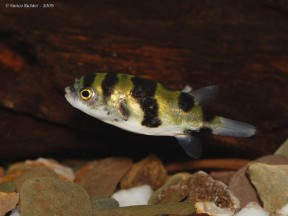
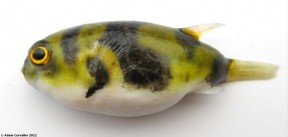
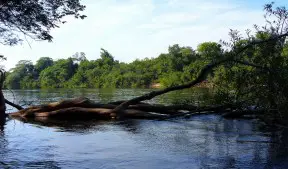
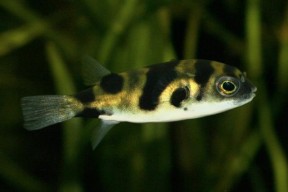
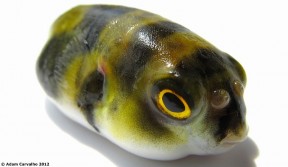
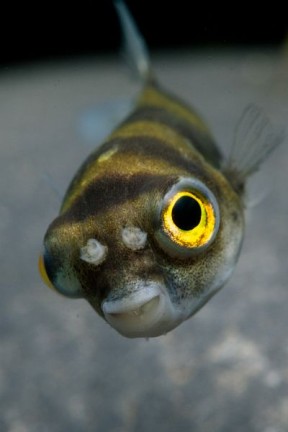
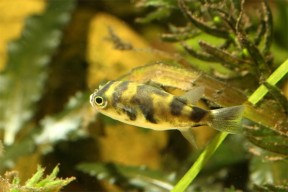
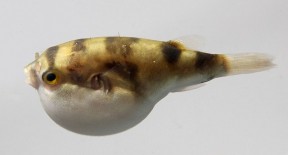

August 1st, 2015 at 2:18 am
Its really hard to identify C.asellus from C.psittacus, the best way I found out is to count the black bars on their body. C.asellus has 5 bars and C.psittacus has 6.